2019 TOYOTA PROACE VERSO engine
[x] Cancel search: enginePage 200 of 505
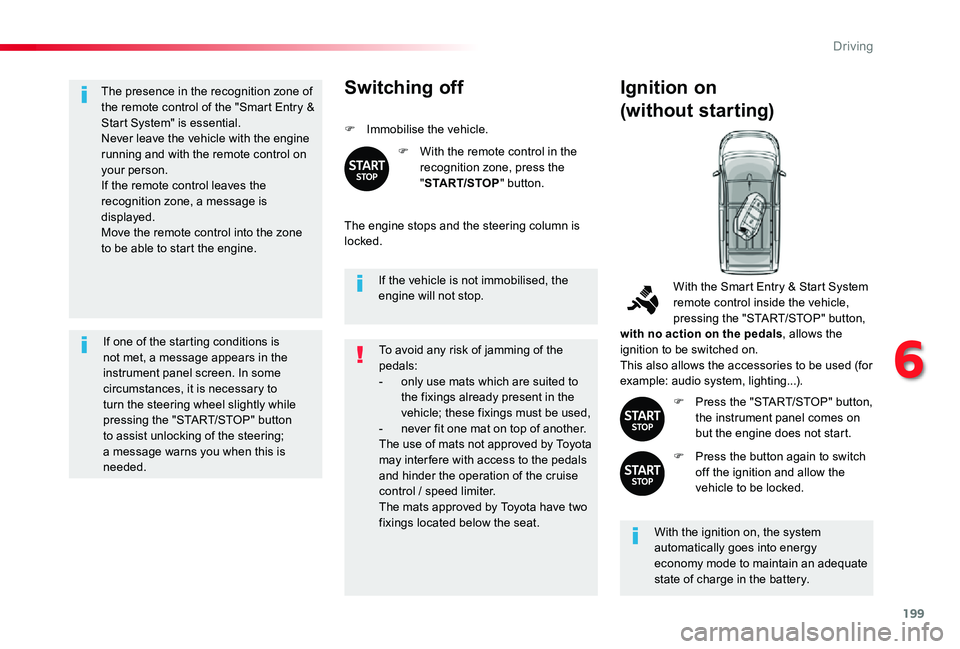
199
The presence in the recognition zone of the remote control of the "Smart Entry & Start System" is essential.Never leave the vehicle with the engine running and with the remote control on your person.If the remote control leaves the recognition zone, a message is displayed.Move the remote control into the zone to be able to start the engine.
If one of the starting conditions is not met, a message appears in the instrument panel screen. In some circumstances, it is necessary to turn the steering wheel slightly while pressing the "START/STOP" button to assist unlocking of the steering; a message warns you when this is needed.
If the vehicle is not immobilised, the engine will not stop.
Switching off
F Immobilise the vehicle.
F With the remote control in the recognition zone, press the "START/STOP" button.
The engine stops and the steering column is locked.
Ignition on
(without starting)
With the ignition on, the system automatically goes into energy economy mode to maintain an adequate state of charge in the battery.
With the Smart Entry & Start System remote control inside the vehicle, pressing the "START/STOP" button, with no action on the pedals, allows the ignition to be switched on.This also allows the accessories to be used (for example: audio system, lighting...).
F Press the "START/STOP" button, the instrument panel comes on but the engine does not start.
F Press the button again to switch off the ignition and allow the vehicle to be locked.
To avoid any risk of jamming of the pedals:- only use mats which are suited to the fixings already present in the vehicle; these fixings must be used,- never fit one mat on top of another.The use of mats not approved by Toyota
may inter fere with access to the pedals and hinder the operation of the cruise control / speed limiter.The mats approved by Toyota have two fixings located below the seat.
6
Driving
Page 201 of 505
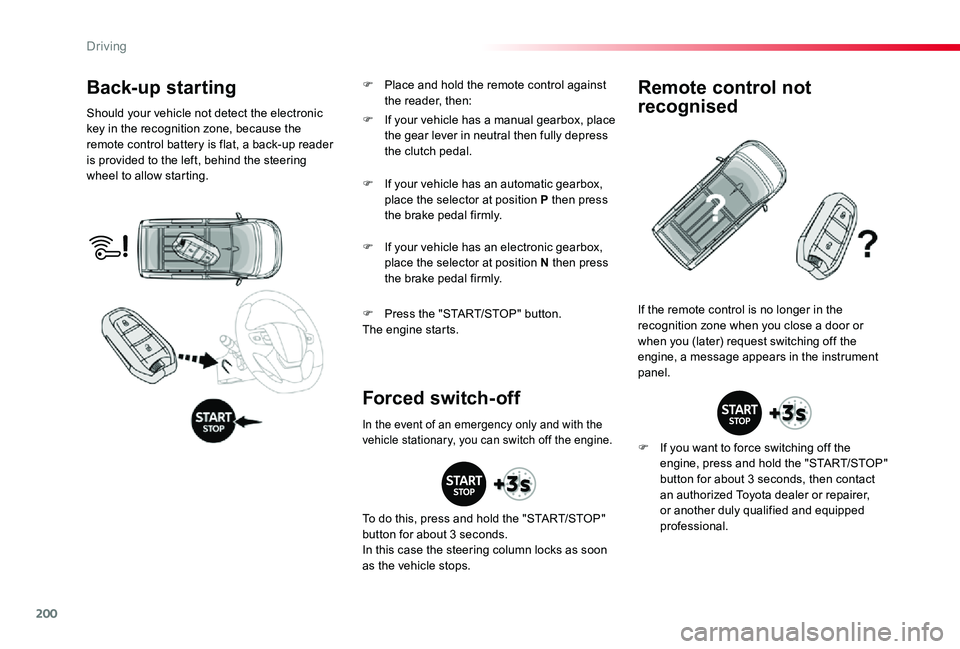
200
Back-up starting
Should your vehicle not detect the electronic key in the recognition zone, because the remote control battery is flat, a back-up reader is provided to the left, behind the steering wheel to allow starting.
F Press the "START/STOP" button.The engine starts.
If the remote control is no longer in the recognition zone when you close a door or when you (later) request switching off the engine, a message appears in the instrument panel.
Forced switch-off
Remote control not
recognised
F If you want to force switching off the engine, press and hold the "START/STOP" button for about 3 seconds, then contact an authorized Toyota dealer or repairer, or another duly qualified and equipped professional.
F If your vehicle has a manual gearbox, place the gear lever in neutral then fully depress the clutch pedal.
F If your vehicle has an automatic gearbox, place the selector at position P then press the brake pedal firmly.
F If your vehicle has an electronic gearbox, place the selector at position N then press the brake pedal firmly.
In the event of an emergency only and with the vehicle stationary, you can switch off the engine.
To do this, press and hold the "START/STOP" button for about 3 seconds.
In this case the steering column locks as soon as the vehicle stops.
F Place and hold the remote control against the reader, then:
Driving
Page 202 of 505
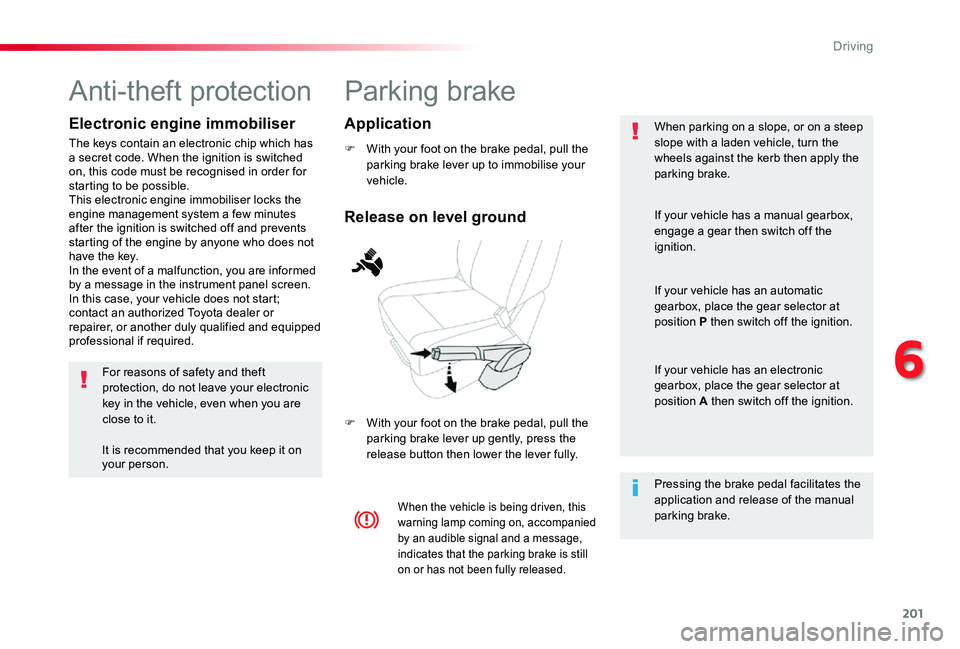
201
Parking brake
F With your foot on the brake pedal, pull the parking brake lever up to immobilise your vehicle.
F With your foot on the brake pedal, pull the parking brake lever up gently, press the release button then lower the lever fully.
When parking on a slope, or on a steep slope with a laden vehicle, turn the wheels against the kerb then apply the parking brake.
When the vehicle is being driven, this warning lamp coming on, accompanied by an audible signal and a message, indicates that the parking brake is still on or has not been fully released.
Pressing the brake pedal facilitates the application and release of the manual parking brake.
If your vehicle has a manual gearbox, engage a gear then switch off the ignition.
If your vehicle has an automatic gearbox, place the gear selector at position P then switch off the ignition.
If your vehicle has an electronic gearbox, place the gear selector at position A then switch off the ignition.
Release on level ground
Application
Anti-theft protection
Electronic engine immobiliser
The keys contain an electronic chip which has a secret code. When the ignition is switched on, this code must be recognised in order for starting to be possible.This electronic engine immobiliser locks the engine management system a few minutes after the ignition is switched off and prevents starting of the engine by anyone who does not have the key.In the event of a malfunction, you are informed by a message in the instrument panel screen.In this case, your vehicle does not start; contact an authorized Toyota dealer or repairer, or another duly qualified and equipped professional if required.
For reasons of safety and theft protection, do not leave your electronic key in the vehicle, even when you are close to it.
It is recommended that you keep it on your person.
6
Driving
Page 203 of 505
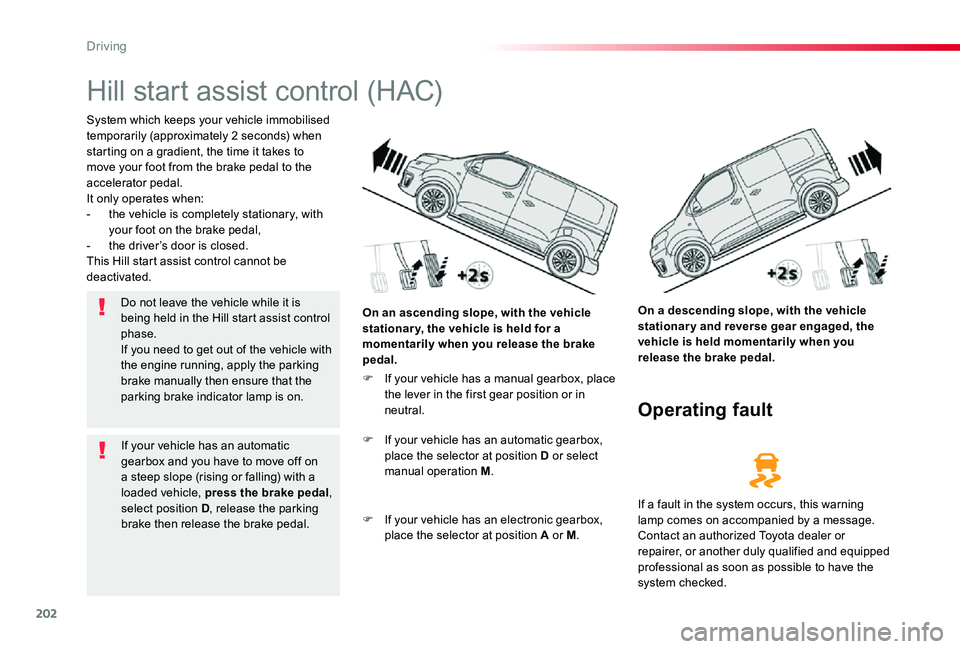
202
Hill start assist control (HAC)
System which keeps your vehicle immobilised temporarily (approximately 2 seconds) when starting on a gradient, the time it takes to move your foot from the brake pedal to the accelerator pedal.It only operates when:- the vehicle is completely stationary, with your foot on the brake pedal,- the driver’s door is closed.This Hill start assist control cannot be deactivated.
On a descending slope, with the vehicle stationary and reverse gear engaged, the vehicle is held momentarily when you release the brake pedal.
On an ascending slope, with the vehicle stationar y, the vehicle is held for a momentarily when you release the brake pedal.
Operating fault
F If your vehicle has a manual gearbox, place the lever in the first gear position or in neutral.
F If your vehicle has an automatic gearbox,
place the selector at position D or select manual operation M.
F If your vehicle has an electronic gearbox, place the selector at position A or M.
If a fault in the system occurs, this warning lamp comes on accompanied by a message. Contact an authorized Toyota dealer or repairer, or another duly qualified and equipped professional as soon as possible to have the system checked.
Do not leave the vehicle while it is being held in the Hill start assist control phase.If you need to get out of the vehicle with the engine running, apply the parking brake manually then ensure that the parking brake indicator lamp is on.
If your vehicle has an automatic gearbox and you have to move off on a steep slope (rising or falling) with a loaded vehicle, press the brake pedal, select position D, release the parking brake then release the brake pedal.
Driving
Page 204 of 505
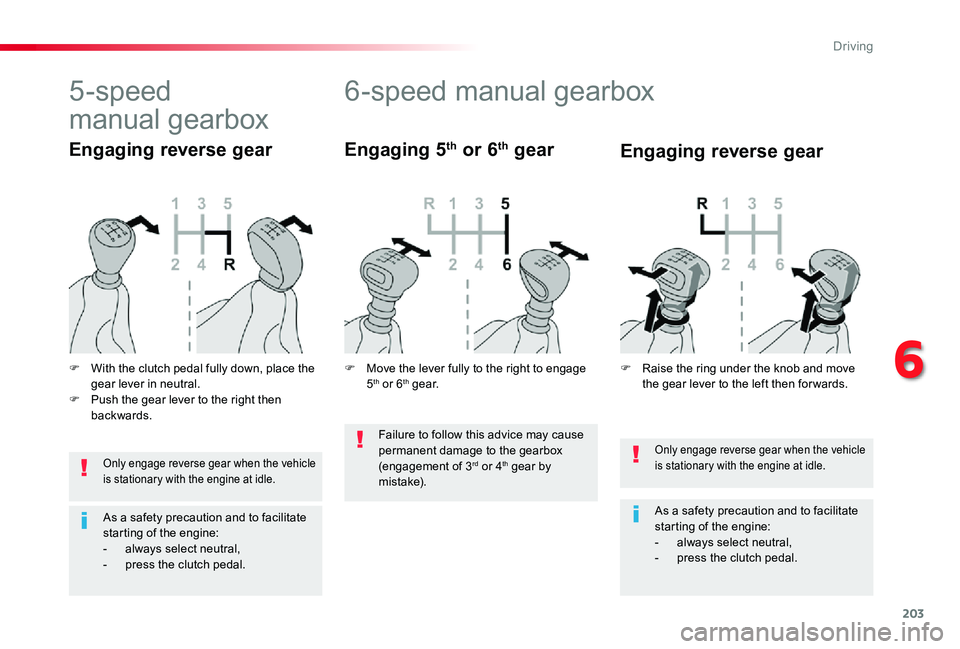
203
Only engage reverse gear when the vehicle is stationary with the engine at idle.
As a safety precaution and to facilitate starting of the engine:- always select neutral,- press the clutch pedal.
6-speed manual gearbox
Engaging 5th or 6th gear
Only engage reverse gear when the vehicle is stationary with the engine at idle.
As a safety precaution and to facilitate starting of the engine:- always select neutral,- press the clutch pedal.
5-speed
manual gearbox
F With the clutch pedal fully down, place the gear lever in neutral.F Push the gear lever to the right then backwards.
Engaging reverse gearEngaging reverse gear
F Raise the ring under the knob and move the gear lever to the left then for wards.F Move the lever fully to the right to engage 5th or 6th g e a r.
Failure to follow this advice may cause
permanent damage to the gearbox (engagement of 3rd or 4th gear by m i s t a ke).
6
Driving
Page 205 of 505
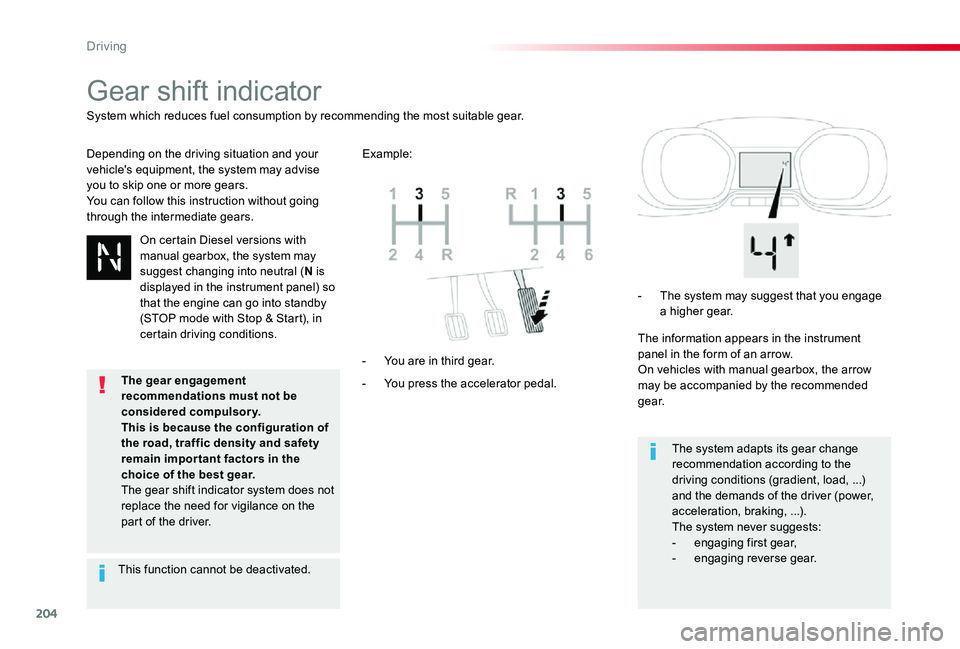
204
Gear shift indicator
Depending on the driving situation and your vehicle's equipment, the system may advise you to skip one or more gears.You can follow this instruction without going through the intermediate gears.
- You press the accelerator pedal.
- You are in third gear.
- The system may suggest that you engage a higher gear.
The information appears in the instrument panel in the form of an arrow.On vehicles with manual gearbox, the arrow may be accompanied by the recommended g e a r.
The system adapts its gear change recommendation according to the driving conditions (gradient, load, ...) and the demands of the driver (power, acceleration, braking, ...).The system never suggests:- engaging first gear,- engaging reverse gear.
System which reduces fuel consumption by recommending the most suitable gear.
Example:
On certain Diesel versions with
manual gearbox, the system may suggest changing into neutral (N is displayed in the instrument panel) so that the engine can go into standby (STOP mode with Stop & Start), in certain driving conditions.
This function cannot be deactivated.
The gear engagement recommendations must not be considered compulsory.This is because the configuration of the road, traffic density and safety remain impor tant factors in the choice of the best gear.The gear shift indicator system does not replace the need for vigilance on the part of the driver.
Driving
Page 207 of 505
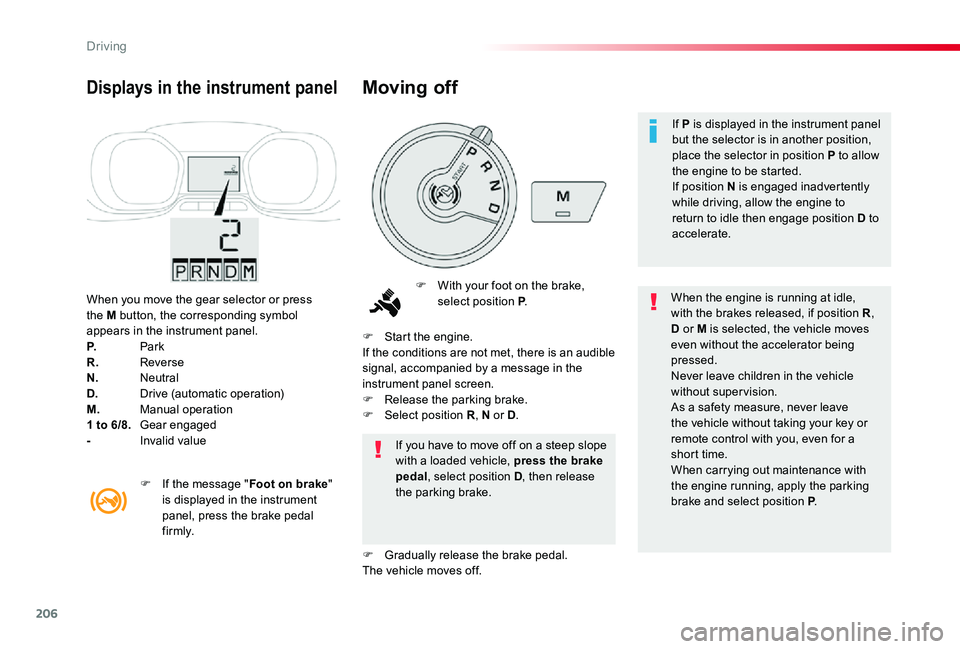
206
When you move the gear selector or press the M button, the corresponding symbol appears in the instrument panel.P. ParkR. ReverseN. NeutralD. Drive (automatic operation)M. Manual operation1 to 6/8. Gear engaged- Invalid value
Displays in the instrument panel
F With your foot on the brake, select position P.When the engine is running at idle, with the brakes released, if position R, D or M is selected, the vehicle moves even without the accelerator being pressed.Never leave children in the vehicle without supervision.As a safety measure, never leave the vehicle without taking your key or remote control with you, even for a
short time.When carrying out maintenance with the engine running, apply the parking brake and select position P.
If you have to move off on a steep slope with a loaded vehicle, press the brake pedal, select position D, then release the parking brake.
F Start the engine.If the conditions are not met, there is an audible signal, accompanied by a message in the instrument panel screen.F Release the parking brake.F Select position R, N or D.
F Gradually release the brake pedal.The vehicle moves off.
F If the message "Foot on brake" is displayed in the instrument panel, press the brake pedal f i r m l y.
Moving off
If P is displayed in the instrument panel but the selector is in another position, place the selector in position P to allow the engine to be started.If position N is engaged inadvertently while driving, allow the engine to return to idle then engage position D to accelerate.
Driving
Page 208 of 505
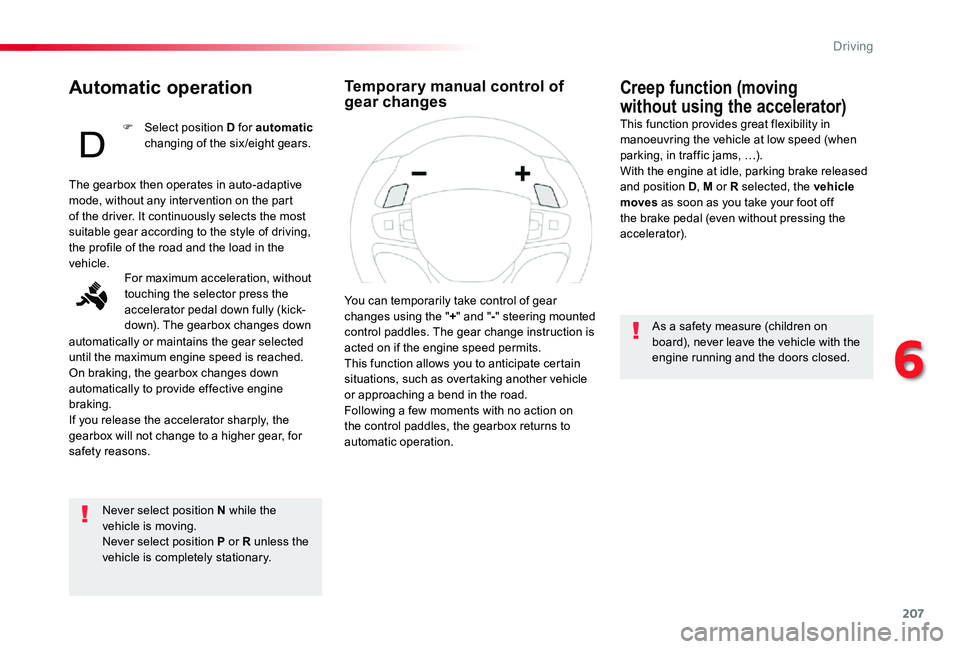
207
Automatic operation
Never select position N while the vehicle is moving.Never select position P or R unless the vehicle is completely stationary.
Creep function (moving
without using the accelerator)This function provides great flexibility in manoeuvring the vehicle at low speed (when parking, in traffic jams, …).With the engine at idle, parking brake released and position D, M or R selected, the vehicle moves as soon as you take your foot off the brake pedal (even without pressing the accelerator).
As a safety measure (children on board), never leave the vehicle with the engine running and the doors closed.
The gearbox then operates in auto-adaptive mode, without any inter vention on the part of the driver. It continuously selects the most suitable gear according to the style of driving, the profile of the road and the load in the vehicle.For maximum acceleration, without touching the selector press the accelerator pedal down fully (kick-down). The gearbox changes down
automatically or maintains the gear selected until the maximum engine speed is reached.On braking, the gearbox changes down automatically to provide effective engine braking.If you release the accelerator sharply, the gearbox will not change to a higher gear, for
safety reasons.
F Select position D for automatic changing of the six/eight gears.
You can temporarily take control of gear changes using the "+" and "-" steering mounted control paddles. The gear change instruction is acted on if the engine speed permits.This function allows you to anticipate certain situations, such as overtaking another vehicle or approaching a bend in the road.Following a few moments with no action on the control paddles, the gearbox returns to automatic operation.
Temporary manual control of gear changes
6
Driving